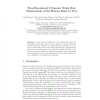Free Online Productivity Tools
i2Speak
i2Symbol
i2OCR
iTex2Img
iWeb2Print
iWeb2Shot
i2Type
iPdf2Split
iPdf2Merge
i2Bopomofo
i2Arabic
i2Style
i2Image
i2PDF
iLatex2Rtf
Sci2ools
FIMH
2001
Springer
2001
Springer
Two-Dimensional Ultrasonic Strain Rate Measurement of the Human Heart in Vivo
In this study, the feasibility of two-dimensional strain rate estimation of the human heart in vivo is shown. To do this, ultrasonic B-mode data were captured at a high temporal resolution of 3.7 ms and processed off-line. The motion of the radio-frequency signal patterns within the two-dimensional sector image was tracked and used as the basis for strain rate estimation. Both axial and lateral motion and strain rate estimates showed a good agreement with the results obtained by more established, one-dimensional techniques.
FIMH 2001 | Medical Imaging | Strain Rate Estimates | Strain Rate Estimation | Two-dimensional Strain Rate |
| Added | 28 Jul 2010 |
| Updated | 28 Jul 2010 |
| Type | Conference |
| Year | 2001 |
| Where | FIMH |
| Authors | Jan D'hooge, Fadi Jamal, Bart Bijnens, Jan Thoen, Frans Van de Werf, George R. Sutherland, Paul Suetens |
Comments (0)

